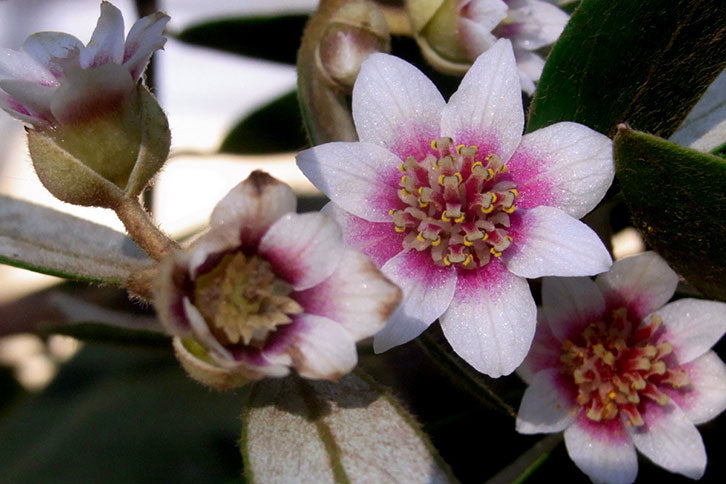Tasmanian Blackheart Sassafras – Unique and Distinctive
Tasmanian Blackheart Sassafras – Unique And Distinctive

Tasmanian blackheart sassafras (Atherosperma moschatum) is an evergreen tree native to cool, temperate southern Australian rainforests. First described by French naturalist Jacques Labillardière in 1806, it was named for the unusual dark streaks that often run through the golden-grey wood. These streaks are the hallmark feature of this unique and beautiful wood. Tasmanian sassafras is the only species in its genus and is one of only a few members of the family Atherospermataceae, which also contains yellow sassafras (Doryphora sassafras) and several other Australian rainforest trees.
Characteristics
Tasmanian sassafras is naturally a golden-grey colour, but its common name, blackheart sassafras, refers to the characteristic brown, black, or even sometimes purple or green streaks that form through the heart of the wood. These streaks occur when a living tree suffers some sort of trauma, such as storm damage, that allows fungus to enter into the wood and stain it. Far from being a problem, this is actually what makes blackheart sassafras so recognisable – and so sought after.
Sassafras are conical in shape and can grow up to 45 metres tall and 1 metre in diameter, though when growing as part of the forest understorey they usually reach no more than 6–25 metres in height and 75 cm in diameter. They have bumpy, porous, aromatic bark that smells of cinnamon, and pale green saw-toothed leaves, which have a sarsaparilla-like fragrance.
Sassafras trees produce flowers of both sexes in winter. The flowers are white with a yellow or maroon centre, and form in a downward-facing direction to protect them from rain and snow. In summer the fruit capsules release seeds, which are then dispersed by wind.
Distribution
Tasmanian sassafras is one of the most abundant species in Tasmania’s native rainforests, particularly throughout the eastern and western mountain ranges, as it thrives in cool, damp, well-drained soil. It also occurs less frequently throughout Victoria and New South Wales, extending as far north as the Tia River, west of Port Macquarie. Sassafras prefers gullies and creek beds in higher altitudes of up to 800 metres, but also grows at sea level. These trees are often found in areas that are inaccessible to animals, such as on mounds or trunks of other plants, since native animals often eat young seedlings.
Ecological and cultural importance
Tasmanian sassafras is an important part of the rainforest ecosystem, as it is the primary host for over 50 lichen species. The trees are critical for the survival of many of these lichen species, particularly in fire-prone Tasmanian eucalyptus woodland.
Tasmanian sassafras has traditionally been used in clothes pegs due to its low tannin content, which means that it does not stain fabrics. The cinnamon-scented bark has also been used to create a flavoured drink by infusing it in water. However, today it is mostly used in decorative items and furniture.
Sustainability
Tasmanian sassafras grows well with reasonably fertile soil, and can live for up to 200 years. It releases large quantities of feathery seeds in summer that can be widely dispersed. However, germination can be unreliable and native animals often eat seedlings. Nonetheless, its numbers are well maintained and it is not considered threatened, as over 80% of Tasmanian sassafras grows inside protected reserves. Sassafras is mostly sourced from eucalypt forests that are certified to the Australian Forest Certification Scheme, meaning that they practise sustainable harvesting. It is rarely cultivated because of its specific temperature and moisture requirements, which are difficult to replicate outside of natural rainforests. Its availability is limited and it tends to be exported only rarely and in small amounts.
Woodworking
Tasmanian sassafras is frequently used for its timber, which is solid yet light and does not tend to split. While it has poor in-ground and external durability, it is great for internal applications. It is quite soft and easily worked both by hand and with tools, lending itself to use in furniture, panelling, joinery, veneers and wood turning.
Blackheart sassafras is often cut in quarters so it can be ‘bookmatched’. This means that adjoining wood surfaces mirror each other, giving a pleasing symmetry. By arranging panels of wood in creative ways, it is possible to achieve a range of stunning effects.
Blackheart sassafras is also often used in musical instruments and decorative pieces such as bowls and carvings, as its dynamic dark brown and black streaks along with interspersed knots create a unique and distinctive appearance. And unlike most other woods, blackheart sassafras comes with a guarantee that no two pieces will ever look quite alike.






